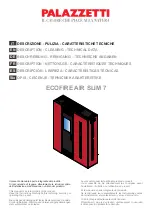
6
Bakechef Range
Issue 01 06/21
4.0
Important Safety Information
4.1.
WARNINGS AND IMPORTANT SAFETY INFORMATION
4.1.1.
READ THESE INSTRUCTIONS CAREFULLY BEFORE INSTALLATION!
These instructions cover the basic principles to ensure satisfactory installation of the stove,
although detail may need slight modification to suit particular local site conditions. In all cases
the installation must comply with current local regulations including Building Regulations, Local
Authority Byelaws and other specifications or regulations including UK or EU standards referred
to as they affect the installation of the stove. Approved Document J is particularly important for
England and Wales and can be downloaded for no cost at:
Also of importance are Approved Documents (A.D.) L1 A and B conservation of fuel and power.
The Domestic Heating Compliance Guide will also be found useful.
In addition to these instructions the requirements of BS 8303 and BS EN 15287 must be fulfilled.
The installation of a stove is a notifiable building works as defined in the building regulations
and it is a legal requirement under England and Wales Building Regulations that the installation
is either carried out under Local Authority Building Control approval or is installed by a
Competent Person registered with a Government approved Competent Persons Scheme. HETAS
Ltd operate such a Scheme and a listing of their Registered Competent Persons can be found on
their website at
If the stove is being installed in any kind of boat, leisure craft or holiday, temporary living or
camping accommodation, it is strongly recommended that a copy of British Standard BS 8511
–
2010 Code of Practice for Installation of Solid Fuel Heating and Cooking Appliances in Small Craft
is obtained. This gives sound advice on safety aspects of such installation. Installer competence
schemes may also be able to provide advice and training on installation in holiday, temporary
living or non-permanent accommodation.
4.1.2.
Important Chimney Warning
This stove must not
be installed into a shared chimney that serves any other heating appliance.
4.1.3.
Extractor Fan Warning
There must not be an extractor fan fitted in the same room as the stove as this can cause the
stove to emit fumes into the room. If unavoidable the appliance must be checked with Approved
Document (A.D.) 1.21 and necessary action taken. Installer competence schemes such as HETAS
can provide guidance of a pressure test procedure to check safe operation of the stove and flue.
4.1.4.
Cleaning and Chimney Sweeping
The appliance, flue & chimney must be cleaned and checked internally and externally regularly
in use and especially after a period of disuse (e.g. after summer).
Lift down the baffle at least
weekly to check for build up of soot or debris on the top from the flue pipe. Remove the baffle and
check the flue spigot and connector is fully clear at regular intervals. The chimney and flue ways
inside the stove and flue connector itself must be swept at least annually, more often when used
with sooty fuels or damp wood. The chimney or flue can usually be swept through the appliance. A
wire centred sweeps brush with guide wheel is recommended. Any loose, broken or leaking joints
or flue ways MUST be repaired immediately. To clean the flue ways of the appliance 3 access








































